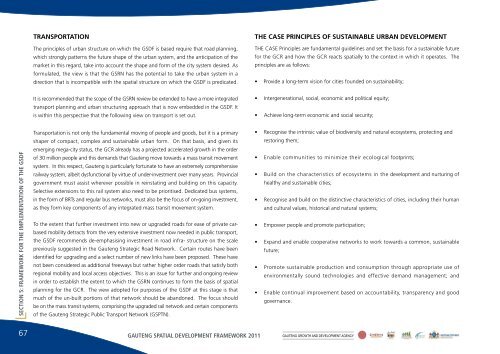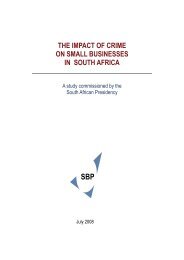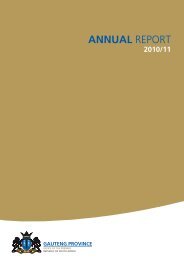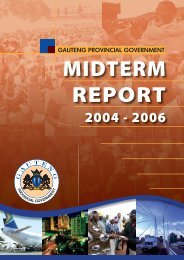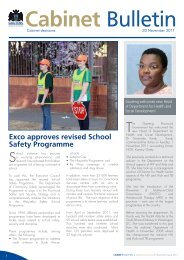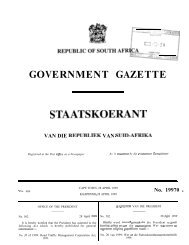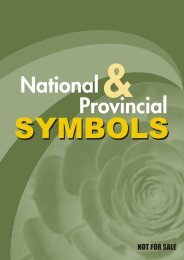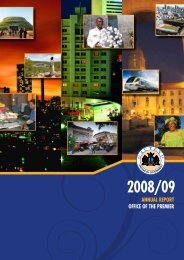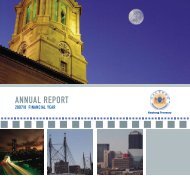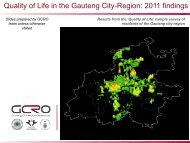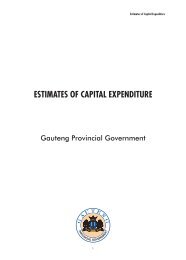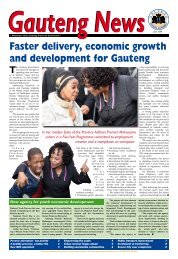the gauteng spatial development framework - Gauteng Online
the gauteng spatial development framework - Gauteng Online
the gauteng spatial development framework - Gauteng Online
You also want an ePaper? Increase the reach of your titles
YUMPU automatically turns print PDFs into web optimized ePapers that Google loves.
TRANSPORTATIONThe principles of urban structure on which <strong>the</strong> GSDF is based require that road planning,which strongly patterns <strong>the</strong> future shape of <strong>the</strong> urban system, and <strong>the</strong> anticipation of <strong>the</strong>market in this regard, take into account <strong>the</strong> shape and form of <strong>the</strong> city system desired. Asformulated, <strong>the</strong> view is that <strong>the</strong> GSRN has <strong>the</strong> potential to take <strong>the</strong> urban system in adirection that is incompatible with <strong>the</strong> <strong>spatial</strong> structure on which <strong>the</strong> GSDF is predicated.THE CASE PRINCIPLES OF SUSTAINABLE URBAN DEVELOPMENTTHE CASE Principles are fundamental guidelines and set <strong>the</strong> basis for a sustainable futurefor <strong>the</strong> GCR and how <strong>the</strong> GCR reacts <strong>spatial</strong>ly to <strong>the</strong> context in which it operates. Theprinciples are as follows:• Provide a long-term vision for cities founded on sustainability;It is recommended that <strong>the</strong> scope of <strong>the</strong> GSRN review be extended to have a more integratedtransport planning and urban structuring approach that is now embedded in <strong>the</strong> GSDF. Itis within this perspective that <strong>the</strong> following view on transport is set out.• Intergenerational, social, economic and political equity;• Achieve long-term economic and social security;SECTION 5: FRAMEWORK FOR THE IMPLEMENTATION OF THE GSDFTransportation is not only <strong>the</strong> fundamental moving of people and goods, but it is a primaryshaper of compact, complex and sustainable urban form. On that basis, and given itsemerging mega-city status, <strong>the</strong> GCR already has a projected accelerated growth in <strong>the</strong> orderof 30 million people and this demands that <strong>Gauteng</strong> move towards a mass transit movementsystem. In this respect, <strong>Gauteng</strong> is particularly fortunate to have an extremely comprehensiverailway system, albeit dysfunctional by virtue of under-investment over many years. Provincialgovernment must assist wherever possible in reinstating and building on this capacity.Selective extensions to this rail system also need to be prioritised. Dedicated bus systems,in <strong>the</strong> form of BRTs and regular bus networks, must also be <strong>the</strong> focus of on-going investment,as <strong>the</strong>y form key components of any integrated mass transit movement system.To <strong>the</strong> extent that fur<strong>the</strong>r investment into new or upgraded roads for ease of private carbasedmobility detracts from <strong>the</strong> very extensive investment now needed in public transport,<strong>the</strong> GSDF recommends de-emphasising investment in road infra- structure on <strong>the</strong> scalepreviously suggested in <strong>the</strong> <strong>Gauteng</strong> Strategic Road Network. Certain routes have beenidentified for upgrading and a select number of new links have been proposed. These havenot been considered as additional freeways but ra<strong>the</strong>r higher order roads that satisfy bothregional mobility and local access objectives. This is an issue for fur<strong>the</strong>r and ongoing reviewin order to establish <strong>the</strong> extent to which <strong>the</strong> GSRN continues to form <strong>the</strong> basis of <strong>spatial</strong>planning for <strong>the</strong> GCR. The view adopted for purposes of <strong>the</strong> GSDF at this stage is thatmuch of <strong>the</strong> un-built portions of that network should be abandoned. The focus shouldbe on <strong>the</strong> mass transit systems, comprising <strong>the</strong> upgraded rail network and certain componentsof <strong>the</strong> <strong>Gauteng</strong> Strategic Public Transport Network (GSPTN).• Recognise <strong>the</strong> intrinsic value of biodiversity and natural ecosystems, protecting andrestoring <strong>the</strong>m;• Enable communities to minimize <strong>the</strong>ir ecological footprints;• Build on <strong>the</strong> characteristics of ecosystems in <strong>the</strong> <strong>development</strong> and nurturing ofhealthy and sustainable cities;• Recognise and build on <strong>the</strong> distinctive characteristics of cities, including <strong>the</strong>ir humanand cultural values, historical and natural systems;• Empower people and promote participation;• Expand and enable cooperative networks to work towards a common, sustainablefuture;• Promote sustainable production and consumption through appropriate use ofenvironmentally sound technologies and effective demand management; and• Enable continual improvement based on accountability, transparency and goodgovernance.67 GAUTENG SPATIAL DEVELOPMENT FRAMEWORK 2011 GAUTENG GROWTH AND DEVELOPMENT AGENCY


